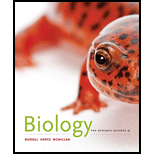
Concept explainers
Which of the following statements about osmoregulation is true?
a. In freshwater invertebrates, salts move out of the body into the water because the animal is hypoosmotic to the water.
b. A marine teleost has to fight gaining water because it is isoosmotic to the sea.
c. Most land animals are osmoconformers.
d. Vertebrates are usually osmoregulators.
e. Terrestrial animals can regulate their osmolarity withoutexpending energy.
Introduction:
Maintenance of the organism’s body fluid through passive regulation of water content is known as osmoregulation. It also helps in maintaining the ion balance while getting rid of metabolic wastes from the body. It can be regulated by osmosis and passive diffusion.
The movement of molecules from high concentrated region to low concentration region through a semipermeable membrane is called osmosis. Osmosis is also a form of passive diffusion. On the basis of osmolarity, the solution can be divided into three types. The hyperosmotic solution has a higher osmolarity, a solution with lower osmolarity is called hypoosmotic solution, and the solution with the same osmolarity on either side of the membrane is called an isosmotic solution.
Answer to Problem 1TYK
Correct answer:
Vertebrates are usually osmoregulators.
Explanation of Solution
Justification/explanation for the correct answer:
Option (d) states that the vertebrates are usually osmoregulators. All the vertebrates have a mechanism in their body to maintain the composition of extracellular fluids. It constitutes of fluids such as blood, lymph, and interstitial fluid. The concentration of this fluid must be regularly monitored so as to control the concentration as well as the volume of fluid. Hence, option (d) is correct.
Explanation for the incorrect answer:
Option (a) states that in freshwater invertebrates, salts move out of the body into the water because the animal is hypoosmotic to the water. Freshwater vertebrates are hypoosmotic to the water, due to which, the salts move out of the body into the water. Osmoregulation occurs inside a closed body system that occurs usually in vertebrates. Most of the freshwater invertebrates are hyper or isoosmotic regulator. So, it is incorrect.
Option (b) states that marine teleost has to fight to gain water because it is isosmotic to the sea. Marine teleost maintain their body osmolarity with the environment and are called osmoconformers. So, it is incorrect.
Option (c) states that most land animals are osmoconformers. Most of the marine invertebrates are osmoconformers. Land animals maintain a constant and stable internal environment through a process called homeostasis. So, it is incorrect.
Option (e) states that terrestrial animals can regulate their osmoregulatory without expending energy. Terrestrial animals have to spend energy in order to regulate their internal environment. Osmoregulation such as osmosis, diffusion, needs energy when flow is against the concentration gradient. So, it is incorrect.
Hence, options (a), (b), (c), and (e) are incorrect.
Therefore, it can be concluded that vertebrates can maintain the composition of extracellular fluid such as blood, lymph, and interstitial fluid through osmoregulation. The concentration of this fluid must be kept under regulation.
Want to see more full solutions like this?
Chapter 48 Solutions
Biology: The Dynamic Science (MindTap Course List)
- What is behavioral adaptarrow_forward22. Which of the following mutant proteins is expected to have a dominant negative effect when over- expressed in normal cells? a. mutant PI3-kinase that lacks the SH2 domain but retains the kinase function b. mutant Grb2 protein that cannot bind to RTK c. mutant RTK that lacks the extracellular domain d. mutant PDK that has the PH domain but lost the kinase function e. all of the abovearrow_forwardWhat is the label ?arrow_forward
- Can you described the image? Can you explain the question as well their answer and how to get to an answer to an problem like this?arrow_forwardglg 112 mid unit assignment Identifying melting processesarrow_forwardGive only the mode of inheritance consistent with all three pedigrees and only two reasons that support this, nothing more, (it shouldn't take too long)arrow_forward
- Oarrow_forwardDescribe the principle of homeostasis.arrow_forwardExplain how the hormones of the glands listed below travel around the body to target organs and tissues : Pituitary gland Hypothalamus Thyroid Parathyroid Adrenal Pineal Pancreas(islets of langerhans) Gonads (testes and ovaries) Placentaarrow_forward
 Biology: The Dynamic Science (MindTap Course List)BiologyISBN:9781305389892Author:Peter J. Russell, Paul E. Hertz, Beverly McMillanPublisher:Cengage Learning
Biology: The Dynamic Science (MindTap Course List)BiologyISBN:9781305389892Author:Peter J. Russell, Paul E. Hertz, Beverly McMillanPublisher:Cengage Learning Human Biology (MindTap Course List)BiologyISBN:9781305112100Author:Cecie Starr, Beverly McMillanPublisher:Cengage Learning
Human Biology (MindTap Course List)BiologyISBN:9781305112100Author:Cecie Starr, Beverly McMillanPublisher:Cengage Learning Biology (MindTap Course List)BiologyISBN:9781337392938Author:Eldra Solomon, Charles Martin, Diana W. Martin, Linda R. BergPublisher:Cengage Learning
Biology (MindTap Course List)BiologyISBN:9781337392938Author:Eldra Solomon, Charles Martin, Diana W. Martin, Linda R. BergPublisher:Cengage Learning Concepts of BiologyBiologyISBN:9781938168116Author:Samantha Fowler, Rebecca Roush, James WisePublisher:OpenStax College
Concepts of BiologyBiologyISBN:9781938168116Author:Samantha Fowler, Rebecca Roush, James WisePublisher:OpenStax College
 Human Physiology: From Cells to Systems (MindTap ...BiologyISBN:9781285866932Author:Lauralee SherwoodPublisher:Cengage Learning
Human Physiology: From Cells to Systems (MindTap ...BiologyISBN:9781285866932Author:Lauralee SherwoodPublisher:Cengage Learning





